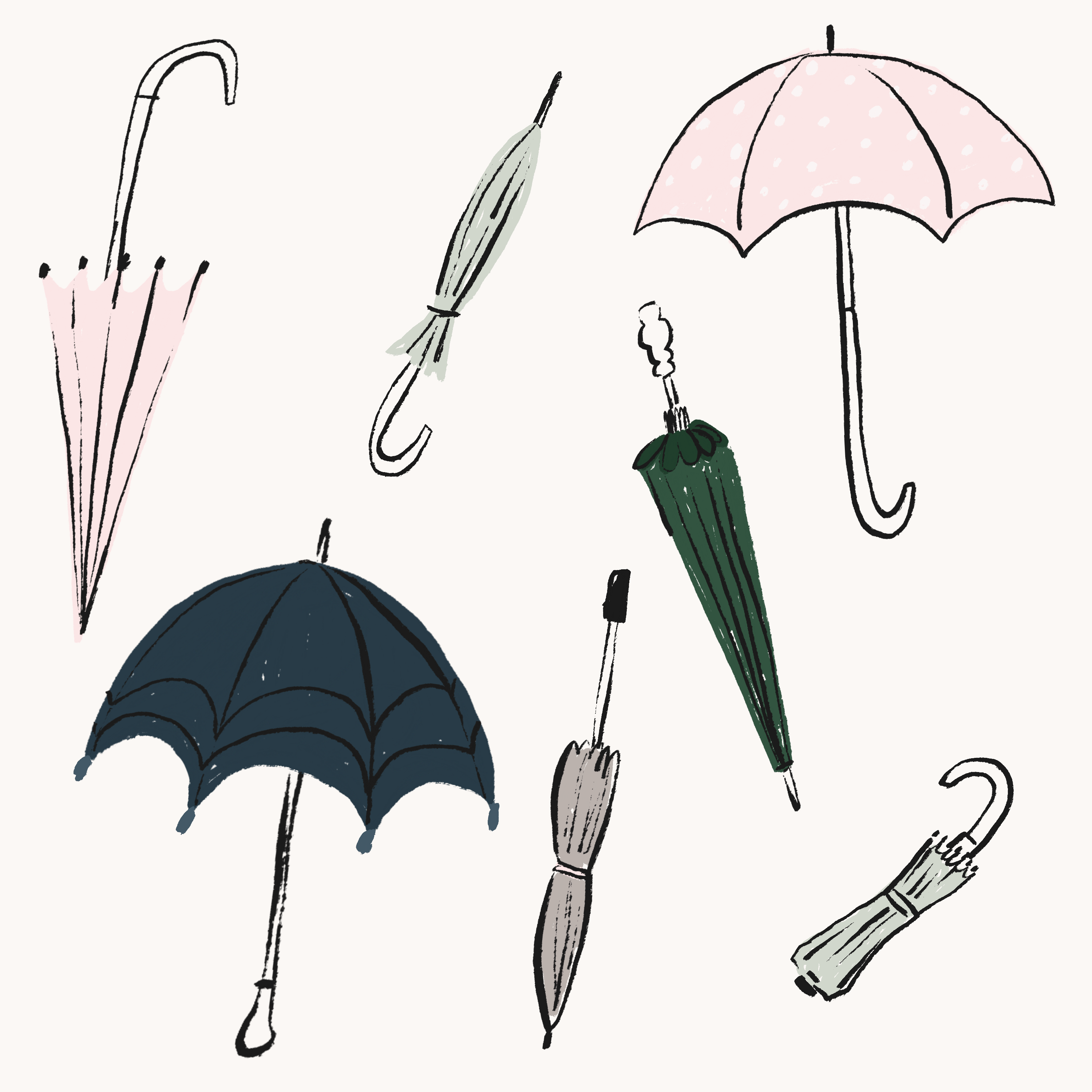In May, I bought my first patio umbrella, a white-and-gray striped looker from Target.
My 14-month-old daughter loves to play on our enclosed balcony, and if you’ve ever tried to put sunscreen on a young toddler, then you’ll know why I looked for an umbrella to keep her in the shade. It’s so much easier this way.
As with any modern shopper, I scrolled past many different types of umbrellas before choosing this one. But I wouldn’t be me if this search didn’t also prompt the thought, “So, what’s the history behind umbrellas, anyway?”
I’ve owned countless rain umbrellas, of course. But despite their ubiquity, the first umbrellas were all about providing our ancestors with shade. The word “umbrella” comes from the Latin word umbra for shadow, and popped up in regions known for intense sun: the Middle East, North Africa, and sub-Saharan Africa. And miles and miles away in China, umbrellas were fashioned from oiled paper stretched over bamboo ribs, and the concept spread to neighboring countries. Their overall shape was inspired by tree canopies—inferring that nature was the true inventor of the umbrella—and to own one was a coveted symbol of power.
The Ancient Egyptians believed that the entire canopy of the sky was formed by the celestial goddess Nut. She stretched across the earth from fingertips to toes, forming a massive dome. Her brother, Geb, was the god of the earth. And their father, Shu, stood between them with two hands reaching up to Nut. The three of them resembled an umbrella, so when the Egypt rulers were shaded, they were demonstrating their mastery of the sun.
The word “umbrella” comes from the Latin word umbra for shadow, and popped up in regions known for intense sun: the Middle East, North Africa, and sub-Saharan Africa.
In West Africa, only chiefs had the right to have umbrellas, which were carried by their slaves. They weren’t dainty by any means, either. These were giant umbrellas, measuring five to 10 feet across, and they were raised up on poles that were six to 10 feet high. These outstretched umbrellas were a crucial part of celebrations and processions, and were bobbed and twirled to music as the crowd moved along.
By 1670, giant sun shades were a common sight in West Africa. French imperialists noticed this, and brought large parasols to Ardra, a major port, as part of their trade for slaves. Then in 1701, Dutch imperialists presented a scarlet, fringed umbrella to the King of Asante of the Akan people in present-day Ghana. When opened, it rose seven feet in the air and measured nearly six feet across. A year later, the Dutch unveiled two more umbrellas, one lined with calico and another framed in gold fringe. British imperialists took this as a competition, and responded by showcasing a nine-foot-wide red umbrella topped with a gilt elephant finial to the king. A version of his umbrella is still a visible part of Asante regalia and culture.
Meanwhile, in Thailand around this same time, some acrobats were using umbrellas to impress royalty during displays of entertainment. In fact, perhaps the award for most inventive umbrella use goes to one acrobat who tied two giant ones to his belt and then leapt from treetops, floating down Mary Poppins style. Traditional Chinese and Japanese weddings used umbrellas as part of their festivities, too, opting for the matron of honor hold a red umbrella over the bride to ward off evil spirits.
Seventeenth-century Europeans similarly thought of umbrellas as an accessory for upper-class women, like a parasol, as they strolled outside. Then, in the early 19th century, Persian traveler and writer Jonas Hanway made a name for himself in England as someone who was always carrying an umbrella (can you blame him given English weather?). His professed love for this fashion-turned-practical accessory led to its rise as a staple of the English gentleman’s uniform. But, I digress—I’m more interested in sun-shading umbrellas at the moment.
The new suburban homes of the 1950s didn’t have front porches, but they did have backyards. And for (the mostly white) Americans with more time and money then they’d ever previously had, the backyard was the perfect place to spend both.
I had to fast-forward to America in the 1950s to find the big patio umbrellas that preceded the one on my balcony. Post-war suburban sprawl introduced the backyard as a place of leisure to an eager middle class looking to settle in cookie-cutter streets of calm. Prior to this decade, backyards were for vegetable gardens and chicken coops—not the Martha Stewart variety, but more of the smelly, unsightly type—as a way for a home to be self-sustaining.
The front porch was where all the leisure activities took place. The new suburban homes of the 1950s didn’t have front porches, but they did have backyards. And for (the mostly white) Americans with more time and money then they’d ever previously had, the backyard was the perfect place to spend both. (For further reading about Black Suburbia, see this article from the New York Public Library.) Decks and patios became must-have features, and wartime manufacturers shifted their focus to serve this lifestyle. Even swimming pools, which were once only accessible to the super rich, were more affordable. To get some shade in the midst of it all, families put up umbrellas.
Americans are still living with architectural decisions and conventions that came to be in that era. My home was built in the 1960s, and it barely has a hint of a front porch—but it does have a balcony that looks out over a backyard. There’s no escaping the heat, so my trusty patio umbrella comes to the rescue. It ensures that my family and I can enjoy our outdoor space, which we are especially thankful for these days. And sometimes, when I want to smile, I think of my toddler under our umbrella as the ruler of her sun-drenched domain.
References
Gordon, Stewart., “In the Shade of the Royal Umbrella.” Saudi Aramco World, (Jul./Aug. 2011) pp. 8-15.
Alpern, Stanley B., “What Africans Got For Their Slaves: A Master List of European Trade Goods.” History in Africa, Vol.22 (1995) pp. 5-43.
Patton, Sharon F., “The Asante Umbrella.” African Arts, Vol 17., No. 4 (Aug. 1984) pp. 64-73; 93-94.
Rankine, Marion., “Brolliology: A History of the Umbrella in Life and Literature.” Melville House, 2017.
Smithsonian Institution Traveling Exhibitions., “Patios, Pools, & the Invention of the American Back Yard.” Had been scheduled to appear next at: Brown County Library, Green Bay, Wisconsin, July 18 2020 – October 11, 2020.








